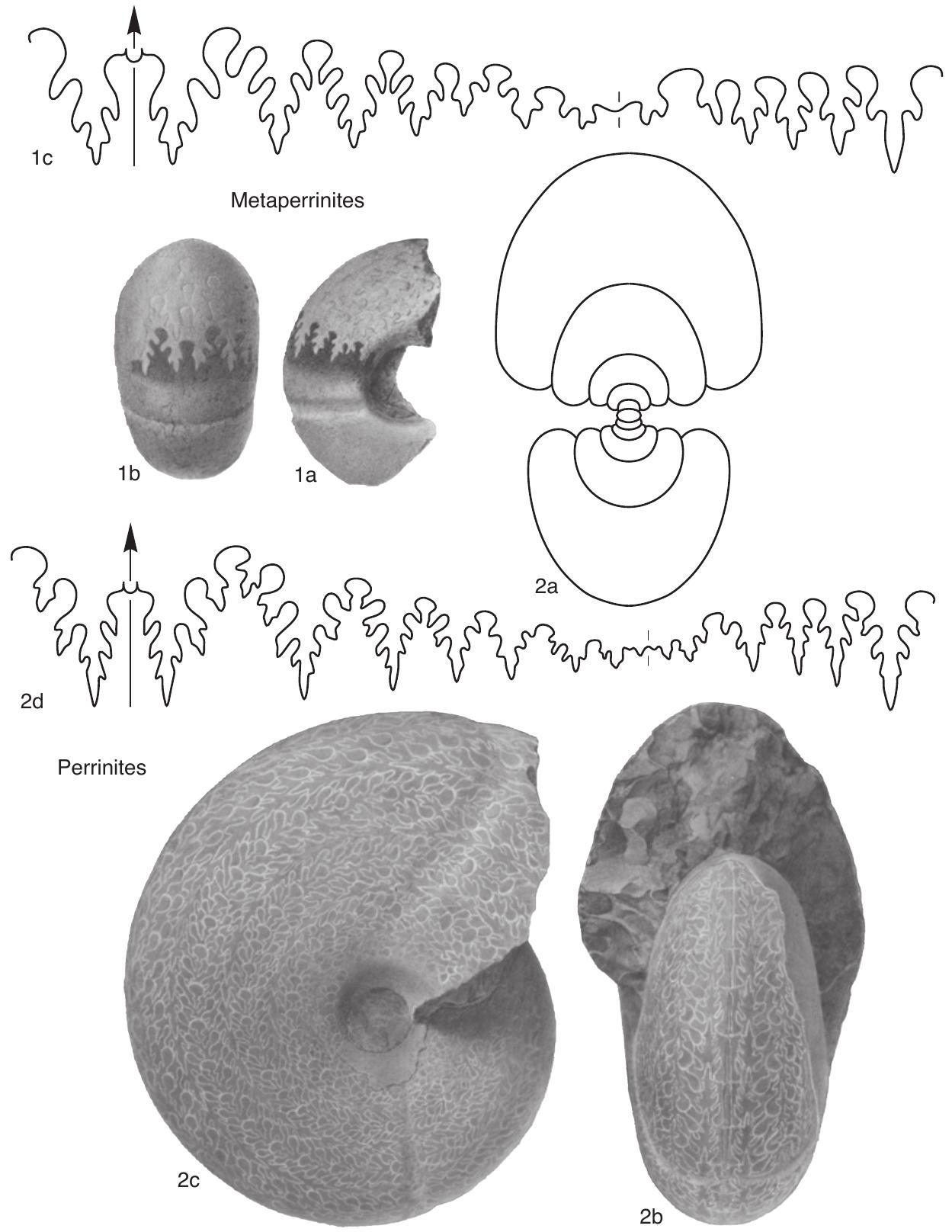Welcome to the Treatise on Invertebrate Paleontology!
Please enter a genera name to retrieve more information.

Metaperrinites
Classification
Phylum:
Mollusca
Class:
Cephalopoda
Subclass:
Ammonoidea
Order:
Goniatitida
Suborder:
Goniatitina
Superfamily:
Shumarditoidea
Family:
Perrinitidae
Formal Genus Name and Reference:
Metaperrinites RUZHENTSEV, 1950, p. 166
Type Species:
Properrinites cumminsi vicinus Miller & FURNISH, 1940a, p. 143, OD
Images
(Click to enlarge in a new window)
Fig. 88, 1 a-c . * M. vicinus (Miller & Furnish), Clyde Formation, Kungurian, northcentral Texas, a-b, X 1.5, c, diameter at 55 mm (Miller & Furnish, 1940a).
Synonyms
Paraperrinites; Shuangyangites; Mapirites; Shyndoceras; Nepirrites; Ripernites
Geographic Distribution
USA (Texas, New Mexico, California, Nevada), Tajikistan (Pamir), Ukraine (?Crimea), China (Guizhou, Guangxi, Jilin, Xinjiang), Thailand (Loei), Indonesia (Timor)
Age Range
Beginning Stage in Treatise Usage:
Cisuralian (Artinskian)
Beginning International Stage:
Artinskian
Fraction Up In Beginning Stage:
0
Beginning Date:
290.51
Ending Stage in Treatise Usage:
Cisuralian (Kungurian)
Ending International Stage:
Kungurian
Fraction Up In Ending Stage:
100
Ending Date:
274.37
Description
Perrinitids intermediate and gradational between Properrinites and Perrinites in size, conch form, depth of hyponomic sinus, and overall complexity of suture. Whorls generally depressed (H/W, 0.7–1.2), and umbilicus variable (Umin/D, 0.1–0.4). Mature sutures display 1–3 first-order subdivisions on ventral flank of each prong of ventral lobe (V1 ), dorsal lobe (D) has either one or two prominent notches on each flank; second-order subdivisions generally weakly developed but may occur in all external saddles in advanced species. Both fourth external lateral saddle and fourth internal lateral saddle generally lie beneath but close to alignment of adjacent saddles. Nine named species.
References
Museum or Author Information
Classification
Phylum:
Mollusca
Class:
Cephalopoda
Subclass:
Ammonoidea
Order:
Goniatitida
Suborder:
Goniatitina
Superfamily:
Shumarditoidea
Family:
Perrinitidae
Formal Genus Name and Reference:
Metaperrinites RUZHENTSEV, 1950, p. 166
Type Species:
Properrinites cumminsi vicinus Miller & FURNISH, 1940a, p. 143, OD
Images
(Click to enlarge in a new window)
Fig. 88, 1 a-c . * M. vicinus (Miller & Furnish), Clyde Formation, Kungurian, northcentral Texas, a-b, X 1.5, c, diameter at 55 mm (Miller & Furnish, 1940a).
Synonyms
Paraperrinites; Shuangyangites; Mapirites; Shyndoceras; Nepirrites; Ripernites
Geographic Distribution
USA (Texas, New Mexico, California, Nevada), Tajikistan (Pamir), Ukraine (?Crimea), China (Guizhou, Guangxi, Jilin, Xinjiang), Thailand (Loei), Indonesia (Timor)
Age Range
Beginning Stage in Treatise Usage:
Cisuralian (Artinskian)
Beginning International Stage:
Artinskian
Fraction Up In Beginning Stage:
0
Beginning Date:
290.51
Ending Stage in Treatise Usage:
Cisuralian (Kungurian)
Ending International Stage:
Kungurian
Fraction Up In Ending Stage:
100
Ending Date:
274.37
Description
Perrinitids intermediate and gradational between Properrinites and Perrinites in size, conch form, depth of hyponomic sinus, and overall complexity of suture. Whorls generally depressed (H/W, 0.7–1.2), and umbilicus variable (Umin/D, 0.1–0.4). Mature sutures display 1–3 first-order subdivisions on ventral flank of each prong of ventral lobe (V1 ), dorsal lobe (D) has either one or two prominent notches on each flank; second-order subdivisions generally weakly developed but may occur in all external saddles in advanced species. Both fourth external lateral saddle and fourth internal lateral saddle generally lie beneath but close to alignment of adjacent saddles. Nine named species.
